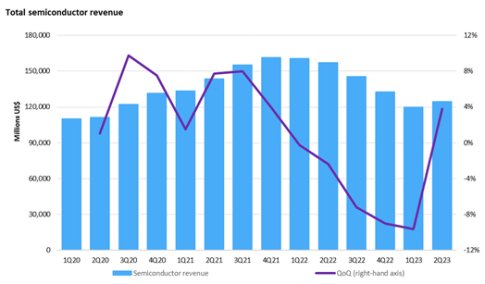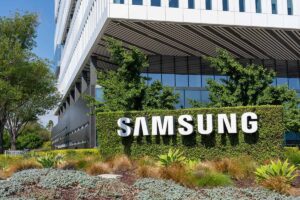The global semiconductor industry plays a pivotal role in our increasingly digital world. As technology continues to advance, the demand for more powerful and efficient chips remains on the rise. ASML Holding, a leading supplier in the semiconductor sector, provides a crucial piece of the puzzle with its lithography machines. In this blog post, we will delve into the recent developments from ASML and the challenges the semiconductor industry is currently facing.
ASML: A Key Player in Semiconductors
ASML Holding, based in the Netherlands, stands as Europe’s most valuable technology company. Their primary contribution to the semiconductor industry lies in supplying advanced lithography machines, essential for manufacturing semiconductors.
Some of their prominent customers include Taiwan Semiconductor Manufacturing (TSM), Samsung Electronics, and Intel. Given ASML’s vital role, it serves as a bellwether for the semiconductor industry’s overall health and stability.
In a recent statement accompanying their earnings report, ASML’s CEO, Peter Wennink, expressed that the year 2024 is expected to be a transition year for the semiconductor industry. The uncertainty surrounding the shape of the industry’s demand recovery is a key factor in this outlook. This uncertainty is compounded by various factors, including the latest U.S.-China tensions.
Read More: Silicon Valley: How a Bunch of Hippies Changed the World
The Impact of U.S.-China Tensions on Semiconductor Industry Recovery
ASML’s revenue projection for the upcoming year has been revised to be broadly flat, mainly due to the heightened uncertainty caused by the United States’ tighter restrictions on exports of artificial intelligence chips. These restrictions, announced on a Tuesday, have created additional headwinds for the semiconductor sector.
Jefferies analyst Janardan Menon suggests that the new U.S. restrictions may partly contribute to ASML’s flat outlook. However, Menon notes that these restrictions apply to a limited number of fabs (semiconductor fabrication facilities) in China. ASML has stated that these restrictions will not affect its overall targets for 2025 and 2030 but may alter the regional balance of its sales.
“The new China restrictions announced by the U.S. government may also be partly responsible for the flat outlook, which ASML interprets as being applicable to a limited number of fabs in China”
~Jefferies analyst Janardan Menon
Read More: China: Too large, Too important & Too strategic to walk away from
Earnings Report
ASML’s recent earnings report for the third quarter revealed a net profit of €1.89 billion, compared to €1.94 billion in the previous quarter. Net sales for the quarter came to €6.67 billion, down from €6.90 billion in the preceding quarter. Notably, net bookings for the quarter fell significantly to €2.60 billion, below Jefferies’ Menon’s forecast of €4.50 billion.
Bookings for ASML’s most advanced systems, extreme ultraviolet lithography machines, amounted to €500 million. It’s worth mentioning that ASML is barred from selling these machines to China.
ASML confirmed that the export restrictions to China would not impact its overall objectives for 2025 and 2030 but would lead to a shift in the geographical distribution of its sales.
ASML’s outlook for the fourth quarter is cautiously optimistic. They anticipate net sales between €6.7 billion and €7.1 billion, with a gross margin ranging between 50% and 51%. They have also reiterated their full-year guidance for net sales growth, aiming for a significant increase of around 30%.
Read More: How TSMC & ASML Monopolised the world?
Looking Ahead: The Path to Semiconductor Industry Recovery
With the latest developments from ASML and the ongoing U.S.-China tensions, the question that arises is when the semiconductor industry’s recovery will begin. ASML remains confident that significant growth will be witnessed in 2025. However, the industry will need to navigate through a series of challenges, including geopolitical tensions and supply chain disruptions, to reach this point.
“Customers continue to be uncertain about the shape of the demand recovery in the industry. We therefore expect 2024 to be a transition year,”
~ASML CEO Peter Wennink
The pressing query now revolves around when the semiconductor industry’s revival will initiate. ASML has indicated its anticipation of substantial growth by the year 2025.
Read More: What is EUV that made ASML the biggest company of Europe
Semiconductor Industry Recovery: Revenue Increases First time Since 2021, Led by Nvidia
According to Omdia’s research, the semiconductor industry saw a 3.8% increase in revenue during the second quarter of 2023, amounting to a total of $124.3 billion. This is a breath of fresh air after a prolonged period of decline, marking a return to historical patterns where second-quarter revenues tend to grow by an average of 3.4% compared to the first quarter.

Read More: Semiconductor Industry Revenue Increases First time Since 2021, Led by Nvidia
Conclusion
The semiconductor industry, a cornerstone of modern technology, is currently facing a period of uncertainty and transition. ASML Holding, as a major supplier of critical semiconductor manufacturing equipment, is closely monitoring these developments. While the chip recovery timeline may be pushed back, the industry remains resilient and adaptable, poised for growth in the years ahead. Stay tuned for further updates as the semiconductor landscape continues to evolve.







